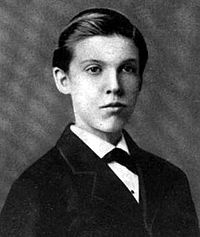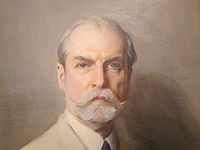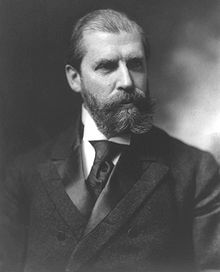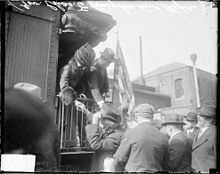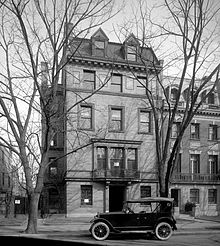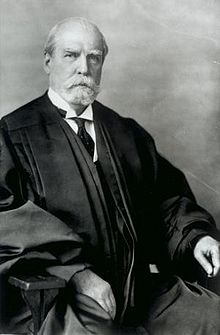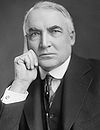- Charles Evans Hughes
-
For other persons of the same name see Charles Evans Hughes, Jr. (1889-1951) and Charles Evans Hughes, III (1915-1985)
Charles Evans Hughes, Sr. 
11th Chief Justice of the United States In office
February 13, 1930[1] – June 30, 1941Nominated by Herbert Hoover Preceded by William Howard Taft Succeeded by Harlan Fiske Stone 44th United States Secretary of State In office
March 5, 1921 – March 4, 1925President Warren G. Harding
Calvin CoolidgePreceded by Bainbridge Colby Succeeded by Frank B. Kellogg Associate Justice of the Supreme Court of the United States In office
October 10, 1910 – June 10, 1916Nominated by William Howard Taft Preceded by David Josiah Brewer Succeeded by John Hessin Clarke 36th Governor of New York In office
January 1, 1907 – October 6, 1910Lieutenant Lewis Chanler (1907–1909)
Horace White (1909–1910)Preceded by Frank W. Higgins Succeeded by Horace White Personal details Born April 11, 1862
Glens Falls, New York, U.S.Died August 27, 1948 (aged 86)
Osterville, Massachusetts, U.S.Political party Republican Spouse(s) Antoinette Carter Hughes Alma mater Madison University,
Brown University,
Columbia UniversityProfession Politician, Lawyer, Professor, Judge. Religion Baptist Charles Evans Hughes, Sr. (April 11, 1862 – August 27, 1948) was an American statesman, lawyer and Republican politician from New York. He served as the 36th Governor of New York (1907–1910), Associate Justice of the Supreme Court of the United States (1910–1916), United States Secretary of State (1921–1925), a judge on the Court of International Justice (1928–1930), and the 11th Chief Justice of the United States (1930–1941). He was the Republican candidate in the 1916 U.S. Presidential election, losing narrowly to Woodrow Wilson.
Hughes was a professor in the 1890s, an important leader of the progressive movement of the 1900s, a leading diplomat and New York lawyer in the days of Harding and Coolidge, and a leader of opposition to the New Deal in the 1930s. Historian Clinton Rossiter has hailed him as a leading American conservative.[2]
Contents
Early life
Charles Evans Hughes was born in Glens Falls, New York, the son of an immigrant father. In 1859, his family moved to New York City, where his mother enrolled him in a private school. He was active in the Northern Baptist church, a Mainline Protestant denomination.
Hughes went to Madison University (now Colgate University) at the age of 14, where he became a member of Delta Upsilon fraternity, then transferred to Brown University, where he continued as a member of Delta Upsilon and graduated in 1881 at age 19, youngest in his class, receiving second-highest honors. He entered Columbia Law School in 1882, and he graduated in 1884 with highest honors. While studying law, he taught at Delaware Academy.
In 1885, he met Antoinette Carter, the daughter of a senior partner of the law firm where he worked, and they were married in 1888. They had one son, Charles Evans Hughes, Jr. and three daughters, one of whom was Elizabeth Hughes Gossett, one of the first humans injected with insulin, and who later served as president of the Supreme Court Historical Society.[3] Hughes was quickly made a partner at the firm now known as Hughes, Hubbard & Reed.
In 1891, Hughes left the practice of law to become a professor at the Cornell University Law School, but in 1893, he returned to his old law firm in New York City. At that time, in addition to practicing law, he taught at New York Law School with Woodrow Wilson. In 1905, he was appointed as counsel to a New York state legislative committee investigating utility rates. His uncovering of corruption led to lower gas rates in New York City. As a result, he was appointed to investigate the insurance industry in New York.
Governor of New York
Hughes served as the Governor of New York from 1907 to 1910. He defeated William Randolph Hearst in the 1906 election to gain the position, and he was the only Republican statewide candidate to win office. In 1908, he was offered the vice-presidential nomination by William Howard Taft, but he declined it to run again for Governor. Theodore Roosevelt became an important supporter of Hughes.[4]
As the Governor, he pushed the passage of the Lessland Act, which gave him the power as governor to oversee civic officials as well as officials in state bureaucracies. This allowed him to fire many corrupt officials. He also managed to have the powers of the state's Public Service Commissions increased, and he attempted unsuccessfully to have their decisions exempted from judicial review. When two bills were passed to reduce railroad fares, Hughes vetoed them on that grounds that the rates should be set by expert commissioners rather than by elected ones. In his final year as the Governor, he had the state comptroller draw up an executive budget. This began a rationalization of state government and eventually it led to an enhancement of executive authority.
In 1908, Governor Hughes reviewed the clemency petition of Chester Gillette concerning the murder of Grace Brown. The governor denied the petition as well as an application for reprieve, and Gillette was electrocuted in March of that year.
When Hughes left office, a prominent journal remarked "One can distinctly see the coming of a New Statism ... [of which] Gov. Hughes has been a leading prophet and exponent".[5] In 1926, Hughes was appointed by New York Governor Alfred E. Smith to be the chairman of a State Reorganization Commission through which Smith's plan to place the Governor as the head of a rationalized state government, was accomplished, bringing to realization what Hughes himself had envisioned.
In 1909, he led an effort to incorporate Delta Upsilon fraternity. This was the first fraternity to incorporate, and he served as its first international president.
Supreme Court
In October 1910, Hughes was appointed as an Associate Justice of the United States Supreme Court. He wrote for the court in Bailey v. Alabama 219 U.S. 219 (1911), which held that involuntary servitude encompassed more than just slavery, and Interstate Commerce Comm. v. Atchison T & SF R Co. 234 U.S. 294 (1914), holding that the Interstate Commerce Commission could regulate intrastate rates if they were significantly intertwined with interstate commerce.
On April 15, 1915, in the case of Frank v. Mangum, the Supreme Court decided (7-2) to deny an appeal made by Leo Frank's attorneys, and instead upheld the decision of lower courts to sustain the guilty verdict against Frank. Justice Hughes and Justice Oliver Wendell Holmes, Jr. were the two dissenting votes.
Presidential candidate
Main article: U.S. presidential election, 1916See also: American entry into World War IHe resigned from the Supreme Court on June 10, 1916,[6] to be the Republican candidate for President in 1916. He was also endorsed by the Progressive Party.[7] Hughes was defeated by Woodrow Wilson in a close election (separated by 23 electoral votes and 594,188 popular votes). The election hinged on California, where Wilson managed to win by 3,800 votes and its 13 electoral votes and thus Wilson was returned for a second term; Hughes had lost the endorsement of the California governor when he failed to show up for an appointment with him.
Hughes returned to public law practice, again at his old firm, Hughes, Rounds, Schurman & Dwight, today known as Hughes Hubbard & Reed LLP.
Secretary of State
Hughes returned to government office in 1921 as Secretary of State under President Harding. As Secretary of State, in 1921 he convened the Washington Naval Conference for the limitation of naval armament among the Great Powers. He continued in office after Harding died and was succeeded by Coolidge, but resigned after Coolidge was elected to a full term. In 1922, June 30, he signed the Hughes–Peynado agreement, that ended the occupation of Dominican Republic by the United States (since 1916).[8]
Various appointments
In 1907, Gov. Charles Evans Hughes became the first president of newly formed Northern Baptist Convention. He also served as President of the New York State Bar Association.
After leaving the State Department, he again rejoined his old partners at the Hughes firm, which included his son and future United States Solicitor General Charles E. Hughes, Jr., and was one of the nation's most sought-after advocates. From 1925 to 1930, for example, Hughes argued over 50 times before the U.S. Supreme Court. From 1926 to 1930, Hughes also served as a member of the Permanent Court of Arbitration and as a judge of the Permanent Court of International Justice in The Hague, Netherlands from 1928 to 1930. He was additionally a delegate to the Pan American Conference on Arbitration and Conciliation from 1928 to 1930. He was one of the co-founders in 1927 of the National Conference on Christians and Jews, now known as the National Conference for Community and Justice (NCCJ), along with S. Parkes Cadman and others, to oppose the Ku Klux Klan, anti-Catholicism, and anti-Semitism in the 1920s and 1930s.[9]
In 1928 conservative business interests tried to interest Hughes in the GOP presidential nomination of 1928 instead of Herbert Hoover. Hughes, citing his age, turned down the offer.
Chief Justice
Herbert Hoover, who had appointed Hughes' son as Solicitor General in 1929, appointed Hughes Chief Justice of the United States in 1930, in which capacity he served until 1941. Hughes replaced former President William Howard Taft, a fellow Republican who had also lost a presidential election to Woodrow Wilson (in 1912) and who, in 1910, had appointed Hughes to his first tenure on the Supreme Court.
His appointment was opposed by progressive elements in both parties who felt that he was too friendly to big business. Idaho Republican William E. Borah said on the United States Senate floor that confirming Hughes would constitute "placing upon the Court as Chief Justice one whose views are known upon these vital and important questions and whose views, in my opinion, however sincerely entertained, are not which ought to be incorporated in and made a permanent part of our legal and economic system."[10] Nonetheless Hughes was confirmed as Chief Justice with a vote of 52 to 26.
In 1937 when President Franklin D. Roosevelt attempted to pack the Court with five additional justices, Hughes worked behind the scenes to defeat the effort, which failed in the Senate.[11] He wrote the opinion for the Court in Near v. Minnesota 283 U.S. 697 (1931), which held that prior restraints against the press are unconstitutional. At first resisting President Roosevelt's New Deal and building a consensus of centrist members of the court, he used his influence to limit the liberal scope Roosevelt's changes. He was often aligned with Justices Louis Brandeis, Harlan Fiske Stone and Benjamin Cardozo in finding some New Deal measures to be Constitutional. Although he wrote the opinion invalidating the National Recovery Administration in Schechter Poultry Corp. v. United States 295 U.S. 495 (1935), he wrote the opinions for the Court in NLRB v. Jones & Laughlin Steel Corp. 301 U.S. 1 (1937), NLRB v. Friedman-Harry Marks Clothing Co., 301 U.S. 58 (1937), and West Coast Hotel v. Parrish 300 U.S. 379 (1937) which looked favorably on New Deal measures.[12]
During Hughes' service as Chief Justice, the Supreme Court moved from its former quarters at the U.S. Capitol to the newly constructed Supreme Court building; the construction of the Supreme Court building had been authorized by Congress during President Taft's service as Chief Justice.
Hughes wrote twice as many constitutional opinions as any of his court's other members. "His opinions, in the view of one commentator, were concise and admirable, placing Hughes in the pantheon of great justices."[13]
His "remarkable intellectual and social gifts . . . made him a superb leader and administrator. He had a photographic memory that few, if any, of his colleagues could match. Yet he was generous, kind, and forebearing in an institution where egos generally come in only one size: extra large!"[13]
Later life
For many years, he was a member of the Union League Club of New York and served as its president from 1917 to 1919.
On August 27, 1948, Hughes died in Osterville, Massachusetts. His remains are interred at Woodlawn Cemetery in Bronx, New York.[14]
Tributes
- Hughes Hall, located at the University of Nevada, Las Vegas is a residence dorm.
- The Charles Evans Hughes House, now the Burmese ambassador's residence, in Washington, D.C. was declared a National Historic Landmark in 1972. Hughes lived in the home from 1930 until his death in 1948.
- Most his papers are in the collection of the manuscript division of the Library of Congress.[15] However other items that could be involved in research are at various institutions around the country.[16]
- Charles Evans Hughes Junior High School (of Woodland Hills, California, now closed) was named in his honor, as was the Hughes Range in Antarctica.
- Charles Evans Hughes High School (of New York City) was named in his honor. It was later renamed High School for the Humanities.
- Hughes Hall is a dormitory at the Cornell Law School, where he once taught.
- Charles Evans Hughes Middle School in Long Beach, California, was named in his honor.
- A bust length portrait of Hughes by the Swiss-born American portrait painter Adolfo Müller-Ury (1862–1947) is in the Michigan Historical Museum in Lansing, Michigan. It was accessioned by them in 1939-1940, but probably acquired earlier.
- The New York City Bar Association has a room named after Charles Evans Hughes. Two portraits of Mr. Hughes are hung in this room as well as one of his son, Charles Evans Hughes Jr.
- The Union League Club of New York, of which Hughes was once president, dedicated the Hughes Room in his honor featuring a portrait of Hughes.
- Hughes Court, an area of the Wriston Quadrangle at Brown University is named for him.
See also
- Demographics of the Supreme Court of the United States
- List of Justices of the Supreme Court of the United States
- List of law clerks of the Supreme Court of the United States
- List of U.S. Supreme Court Justices by time in office
References
- ^ "Federal Judicial Center: Charles Evans Hughes". 2009-12-12. http://www.fjc.gov/servlet/tGetInfo?jid=1113. Retrieved 2009-12-12.
- ^ Clinton Rossiter, Conservatism in America (1962) p. 174
- ^ Elizabeth Hughes: Fifty-eight years on animal-insulin
- ^ Schizer, David M. "Welcoming the J.D. Class of 2014", address at Columbia Law School, August 2011, p. 4
- ^ Nation quoted in Samuel Hendel, Charles Evans Hughes and the Supreme Court (New York: King's Crown Press, 1951), 15, quoted at The History Cooperative
- ^ Supreme Court of the United States Accessed December 13, 2007.
- ^ Eisler, a Justice for All, page 39, ISBN 0-671-76787-9
- ^ Calder, Bruce J. (1984). The impact of intervention: the Dominican Republic during the U.S. occupation of 1916-1924. Markus Wiener Publishers. p. 223. ISBN 9781558763869. http://books.google.com/books?id=YFdkfzVaEa8C&pg=PA223. Retrieved 22 September 2011.
- ^ "National Conference for Community and Justice". http://www.faithstreams.com/topics/members-and-partners/national-conference-for-community-and-justice.html. Retrieved 2007-12-19.
- ^ Wittes, Benjamin. Confirmation Wars: Preserving Independent Courts in Angry Times (Rowman & Littlefield 2006), p. 50
- ^ Jeff Shesol, Supreme power: Franklin Roosevelt vs. the Supreme Court (2010) pp. 394–7
- ^ Felix Frankfurter was not fooled. He wrote to Harlan Fiske Stone of Hughes, "When I see how a synthetic halo is being fitted upon the head of one of the most politically calculating of men, it makes me in the sanctified language of the old gentleman 'puke.'" Schizer, David M. "Welcoming the J.D. Class of 2014", address at Columbia Law School, August 2011, p. 5
- ^ a b Charles Evans Hughes, Official Supreme Court media at Oyez project
- ^ Christensen, George A. (1983) Here Lies the Supreme Court: Gravesites of the Justices, Yearbook Supreme Court Historical Society at Internet Archive.
- ^ Library of Congress, Charles Evans Hughes collection.
- ^ Federal Judicial Center, Hughes Reference materials.
Further reading
- The Recall of Justice Hughes (May, 1916) The World's Work.
- Abraham, Henry J., Justices and Presidents: A Political History of Appointments to the Supreme Court. 3d. ed. (Oxford, Oxfordshire: Oxford University Press, 1992). ISBN 0-19-506557-3.
- Cushman, Clare, The Supreme Court Justices: Illustrated Biographies,1789-1995 (2nd ed.) (Supreme Court Historical Society), (Congressional Quarterly Books, 2001) ISBN 1568021267; ISBN 9781568021263.
- Frank, John P., The Justices of the United States Supreme Court: Their Lives and Major Opinions (Leon Friedman and Fred L. Israel, editors) (Chelsea House Publishers, 1995) ISBN 0791013774, ISBN 978-0791013779.
- Glad, Betty, Charles Evans Hughes and the illusions of innocence: A study in American diplomacy (Urbana, IL: University of Illinois Press, 1966).
- Hall, Kermit L., ed. The Oxford Companion to the Supreme Court of the United States. Oxford, Oxfordshire: Oxford University Press, 1992. ISBN 0195058356; ISBN 9780195058352.
- Martin, Fenton S. and Goehlert, Robert U., The U.S. Supreme Court: A Bibliography, (Congressional Quarterly Books, 1990). ISBN 0871875543.
- Perkins, Dexter, Charles Evans Hughes and American democratic statesmanship (Boston: Little, Brown, 1956).
- Pusey, Merlo J., Charles Evans Hughes, 2 vol. (New York: Macmillan, 1951).. the standard scholarly biography
- Ross, William G., The Chief Justiceship of Charles Evans Hughes, 1930-1941 (Columbia, SC: University of South Carolina Press, 2007) ISBN 1570036799, ISBN 978-1570036799.
- Shesol, Jeff. Supreme Power: Franklin Roosevelt vs. The Supreme Court (W.W. Norton, 2010)
- Urofsky, Melvin I., The Supreme Court Justices: A Biographical Dictionary (New York: Garland Publishing 1994). 590 pp. ISBN 0815311761; ISBN 978-0815311768.
- Wesser, Robert F., Charles Evans Hughes: Politics and reform in New York, 1905-1910 (Ithaca, NY: Cornell University Press, 1967).
External links
- Grave of Charles Evans Hughes at Find a Grave
- "Mr. Hughes Goes to War" (An alternate history where Hughes is elected President of the United States in 1916)
- The Hughes Court at Supreme Court Historical Society.
- Archives
- Judge Manuscript Information: Charles Evans Hughes. List of archives with documents via Judges of the United States Courts. Retrieved April 15, 2005.
- Archives at the Supreme Court Historical Society
- Legal opinions as Chief Justice
- Near v. Minnesota ex rel. Olson, 283 U.S. 697 (1931).
- Schechter Poultry Corp. v. United States, 295 U.S. 495 (1935).
- NLRB v. Jones & Laughlin Steel Corp., 301 U.S. 1 (1937).
- West Coast Hotel v. Parrish, 300 U.S. 379 (1937)
- Books
Political offices Preceded by
Frank W. HigginsGovernor of New York
1907–1910Succeeded by
Horace WhitePreceded by
Bainbridge ColbyUnited States Secretary of State
Served under: Warren G. Harding, Calvin Coolidge
March 4, 1921 – March 4, 1925Succeeded by
Frank B. KelloggLegal offices Preceded by
David Josiah BrewerAssociate Justice of the Supreme Court
of the United States
October 10, 1910 – June 10, 1916Succeeded by
John Hessin ClarkePreceded by
William Howard TaftChief Justice of the United States
February 13, 1930 – June 30, 1941Succeeded by
Harlan Fiske StoneParty political offices Preceded by
William Howard TaftRepublican Party presidential candidate
1916Succeeded by
Warren G. HardingNon-profit organization positions Preceded by
Lawson PurdyPresident of the National Municipal League
1919–1921Succeeded by
Henry M. WaiteAwards and achievements Preceded by
Alfonso XIII of SpainCover of Time Magazine
29 December 1924Succeeded by
Juan BelmonteUnited States Secretary of State Secretary of Foreign Affairs
1781–1789Secretary of State
1789–presentJefferson • Randolph • Pickering • J. Marshall • Madison • Smith • Monroe • Adams • Clay • Van Buren • E. Livingston • McLane • Forsyth • Webster • Upshur • Calhoun • Buchanan • Clayton • Webster • Everett • Marcy • Cass • Black • Seward • Washburne • Fish • Evarts • Blaine • Frelinghuysen • Bayard • Blaine • Foster • Gresham • Olney • Sherman • Day • Hay • Root • Bacon • Knox • Bryan • Lansing • Colby • Hughes • Kellogg • Stimson • Hull • Stettinius • Byrnes • G Marshall • Acheson • Dulles • Herter • Rusk • Rogers • Kissinger • Vance • Muskie • Haig • Shultz • Baker • Eagleburger • Christopher • Albright • Powell • Rice • ClintonCabinet of President Calvin Coolidge (1923–1929) Vice President None (1923–1925) • Charles G. Dawes (1925–1929)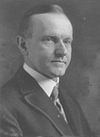
Secretary of State Charles Evans Hughes (1923–1925) • Frank B. Kellogg (1925–1929)Secretary of War John W. Weeks (1923–1925) • Dwight F. Davis (1925–1929)Secretary of the Treasury Attorney General Postmaster General Secretary of the Navy Edwin Denby (1923–1924) • Curtis D. Wilbur (1924–1929)Secretary of the Interior Hubert Work (1923–1928) • Roy Owen West (1928–1929)Secretary of the Agriculture Henry Cantwell Wallace (1923–1924) • Howard Mason Gore (1924–1925) • William Marion Jardine (1925–1929)Secretary of Commerce Herbert Hoover (1923–1928) • William F. Whiting (1928–1929)Secretary of Labor Chief Justices of the United States John Jay • John Rutledge • Oliver Ellsworth • John Marshall • Roger B. Taney • Salmon P. Chase • Morrison Waite • Melville Fuller • Edward Douglass White • William Howard Taft • Charles Evans Hughes • Harlan F. Stone • Fred M. Vinson • Earl Warren • Warren E. Burger • William Rehnquist • John RobertsGovernors and Lieutenant Governors of New York  GovernorsG. Clinton · Jay · G. Clinton · Lewis · Tompkins · Tayler · D. Clinton · Yates · D. Clinton · Pitcher · Van Buren · Throop · Marcy · Seward · Bouck · Wright · Young · Fish · Hunt · Seymour · Clark · King · Morgan · Seymour · Fenton · Hoffman · J. Adams Dix · Tilden · Robinson · Cornell · Cleveland · Hill · Flower · Morton · Black · T. Roosevelt · Odell · Higgins · Hughes · White · J. Alden Dix · Sulzer · Glynn · Whitman · Smith · Miller · Smith · F. Roosevelt · Lehman · Poletti · Dewey · Harriman · Rockefeller · Wilson · Carey · M. Cuomo · Pataki · Spitzer · Paterson · A. CuomoLieutenant GovernorsVan Cortlandt • S. Van Rensselaer • J. Van Rensselaer • Broome • Tayler • Clinton • Tayler • Swift • Tayler • Root • Tallmadge • Pitcher • P. Livingston • Dayan • Throop • Stebbins • Oliver • E. Livingston • Tracy • Bradish • Dickinson • Gardiner • Lester • Fish • Patterson • Church • Raymond • Selden • Campbell • Floyd-Jones • Alvord • Woodford • Beach • Robinson • Dorsheimer • Hoskins • Hill • McCarthy • Jones • Sheehan • Saxton • Woodruff • Higgins • Bruce • Raines • Chanler • White • Cobb • Conway • Glynn • Wagner • Schoeneck • Walker • Wood • Lusk • Lunn • Lowman • Corning • Lehman • Bray • Poletti • Hanley • Wallace • Hanley • Moore • Wicks • Mahoney • DeLuca • Wilson • Anderson • Krupsak • Cuomo • DelBello • Anderson • Lundine • McCaughey • Donohue • Paterson • Bruno • Skelos • Smith • Espada • Ravitch • Smith • Ravitch • Duffy
GovernorsG. Clinton · Jay · G. Clinton · Lewis · Tompkins · Tayler · D. Clinton · Yates · D. Clinton · Pitcher · Van Buren · Throop · Marcy · Seward · Bouck · Wright · Young · Fish · Hunt · Seymour · Clark · King · Morgan · Seymour · Fenton · Hoffman · J. Adams Dix · Tilden · Robinson · Cornell · Cleveland · Hill · Flower · Morton · Black · T. Roosevelt · Odell · Higgins · Hughes · White · J. Alden Dix · Sulzer · Glynn · Whitman · Smith · Miller · Smith · F. Roosevelt · Lehman · Poletti · Dewey · Harriman · Rockefeller · Wilson · Carey · M. Cuomo · Pataki · Spitzer · Paterson · A. CuomoLieutenant GovernorsVan Cortlandt • S. Van Rensselaer • J. Van Rensselaer • Broome • Tayler • Clinton • Tayler • Swift • Tayler • Root • Tallmadge • Pitcher • P. Livingston • Dayan • Throop • Stebbins • Oliver • E. Livingston • Tracy • Bradish • Dickinson • Gardiner • Lester • Fish • Patterson • Church • Raymond • Selden • Campbell • Floyd-Jones • Alvord • Woodford • Beach • Robinson • Dorsheimer • Hoskins • Hill • McCarthy • Jones • Sheehan • Saxton • Woodruff • Higgins • Bruce • Raines • Chanler • White • Cobb • Conway • Glynn • Wagner • Schoeneck • Walker • Wood • Lusk • Lunn • Lowman • Corning • Lehman • Bray • Poletti • Hanley • Wallace • Hanley • Moore • Wicks • Mahoney • DeLuca • Wilson • Anderson • Krupsak • Cuomo • DelBello • Anderson • Lundine • McCaughey • Donohue • Paterson • Bruno • Skelos • Smith • Espada • Ravitch • Smith • Ravitch • DuffyItalics indicate acting officeholders Republican Party Chairpersons
of the RNCMorgan · Raymond · Ward · Claflin · Morgan · Chandler · Cameron · Jewell · Sabin · Jones · Quay · Clarkson · Carter · Hanna · Payne · Cortelyou · New · Hitchcock · Hill · Rosewater · Hilles · Wilcox · Hays · Adams · Butler · Work · Huston · Fess · Sanders · Fletcher · Hamilton · Martin · Walsh · Spangler · Brownell · Reece · Scott · Gabrielson · Summerfield · Roberts · Hall · Alcorn · T. B. Morton · Miller · Burch · Bliss · R. Morton · Dole · Bush · Smith · Brock · Richards · Fahrenkopf · Atwater · Yeutter · Bond · Barbour · Nicholson · Gilmore · Racicot · Gillespie · Mehlman · Martinez · Duncan · Steele · Priebus
Presidential tickets Frémont/Dayton · Lincoln/Hamlin · Lincoln/Johnson · Grant/Colfax · Grant/Wilson · Hayes/Wheeler · Garfield/Arthur · Blaine/Logan · Harrison/Morton · Harrison/Reid · McKinley/Hobart · McKinley/Roosevelt · Roosevelt/Fairbanks · Taft/Sherman/Butler · Hughes/Fairbanks · Harding/Coolidge · Coolidge/Dawes · Hoover/Curtis · Landon/Knox · Willkie/McNary · Dewey/Bricker · Dewey/Warren · Eisenhower/Nixon · Nixon/Lodge · Goldwater/Miller · Nixon/Agnew · Ford/Dole · Reagan/G. H. W. Bush · G. H. W. Bush/Quayle · Dole/Kemp · G. W. Bush/Cheney · McCain/Palin
Parties by state
and territoryStateAlabama · Alaska · Arizona · Arkansas · California · Colorado · Connecticut · Delaware · Florida · Georgia · Hawaii · Idaho · Illinois · Indiana · Iowa · Kansas · Kentucky · Louisiana · Maine · Maryland · Massachusetts · Michigan · Minnesota · Mississippi · Missouri · Montana · Nebraska · Nevada · New Hampshire · New Jersey · New Mexico · New York · North Carolina · North Dakota · Ohio · Oklahoma · Oregon · Pennsylvania · Rhode Island · South Carolina · South Dakota · Tennessee · Texas · Utah · Vermont · Virginia · Washington · West Virginia · Wisconsin · Wyoming
TerritoryDistrict of Columbia · Guam · Northern Mariana Islands · Puerto Rico · Virgin Islands
Conventions
(List)1856 (Philadelphia) · 1860 (Chicago) · 1864 (Baltimore) · 1868 (Chicago) · 1872 (Philadelphia) · 1876 (Cincinnati) · 1880 (Chicago) · 1884 (Chicago) · 1888 (Chicago) · 1892 (Minneapolis) · 1896 (Saint Louis) · 1900 (Philadelphia) · 1904 (Chicago) · 1908 (Chicago) · 1912 (Chicago) · 1916 (Chicago) · 1920 (Chicago) · 1924 (Cleveland) · 1928 (Kansas City) · 1932 (Chicago) · 1936 (Cleveland) · 1940 (Philadelphia) · 1944 (Chicago) · 1948 (Philadelphia) · 1952 (Chicago) · 1956 (San Francisco) · 1960 (Chicago) · 1964 (San Francisco) · 1968 (Miami Beach) · 1972 (Miami Beach) · 1976 (Kansas City) · 1980 (Detroit) · 1984 (Dallas) · 1988 (New Orleans) · 1992 (Houston) · 1996 (San Diego) · 2000 (Philadelphia) · 2004 (New York) · 2008 (St. Paul) · 2012 (Tampa)
Affiliated
organizationsCollege Republicans · Congressional Hispanic Conference · International Democrat Union · Log Cabin Republicans · National Republican Congressional Committee · National Republican Senatorial Committee · Republican Conference of the United States House of Representatives · Republican Conference of the United States Senate · Republican Governors Association · Republican Jewish Coalition · Republican Liberty Caucus · Republican Main Street Partnership · Republican Majority for Choice · Republican National Coalition for Life · Republican National Hispanic Assembly · Republican Study Committee · Republicans Abroad · Republicans for Environmental Protection · The Ripon Society · The Wish List · Young Republicans
Related articles History · 2009 chairmanship election · 2011 chairmanship election · Bibliography · Timeline of modern American conservatism
 Conservatism PortalSupreme Court of the United States
Conservatism PortalSupreme Court of the United StatesThe White Court Chief Justice: Melville Weston Fuller (1888–1910) 1910: J. M. Harlan | J. McKenna | O.W. Holmes | Wm. R. Day | Wm. H. Moody | H.H. Lurton | C.E. Hughes 1911: J. M. Harlan | J. McKenna | O.W. Holmes | Wm. R. Day | H.H. Lurton | C.E. Hughes | W. Van Devanter | J.R. Lamar 1912–1914: J. McKenna | O.W. Holmes | Wm. R. Day | H.H. Lurton | C.E. Hughes | W. Van Devanter | J.R. Lamar | M. Pitney 1914–1916: J. McKenna | O.W. Holmes | Wm. R. Day | C.E. Hughes | W. Van Devanter | J.R. Lamar | M. Pitney | J.C. McReynolds The Hughes Court Chief Justice: Charles Evans Hughes (1930–1941) Feb–Mar 1930: O.W. Holmes | W. Van Devanter | J.C. McReynolds | L.D. Brandeis | Geo. Sutherland | P. Butler | E.T. Sanford | H.F. Stone Jun 1930–1932: O.W. Holmes | W. Van Devanter | J.C. McReynolds | L.D. Brandeis | Geo. Sutherland | P. Butler | H.F. Stone | O.J. Roberts 1932–1937: W. Van Devanter | J.C. McReynolds | L.D. Brandeis | Geo. Sutherland | P. Butler | H.F. Stone | O.J. Roberts | B.N. Cardozo 1937–1938: J.C. McReynolds | L.D. Brandeis | Geo. Sutherland | P. Butler | H.F. Stone | O.J. Roberts | B.N. Cardozo | H. Black 1938: J.C. McReynolds | L.D. Brandeis | P. Butler | H.F. Stone | O.J. Roberts | B.N. Cardozo | H. Black | S.F. Reed 1939: J.C. McReynolds | P. Butler | H.F. Stone | O.J. Roberts | H. Black | S.F. Reed | F. Frankfurter | Wm. O. Douglas 1940–1941: J.C. McReynolds | H.F. Stone | O.J. Roberts | H. Black | S.F. Reed | F. Frankfurter | Wm. O. Douglas | F. Murphy  Categories:
Categories:- United States Secretaries of State
- Harding administration cabinet members
- Coolidge administration cabinet members
- 1862 births
- 1948 deaths
- American legal scholars
- Baptists from the United States
- Brown University alumni
- Burials at Woodlawn Cemetery (Bronx)
- Chief Justices of the United States
- Colgate University alumni
- Columbia Law School alumni
- Cornell University faculty
- Governors of New York
- New York lawyers
- New York Republicans
- People from Glens Falls, New York
- Permanent Court of International Justice judges
- Republican Party (United States) presidential nominees
- United States federal judges appointed by Herbert Hoover
- United States federal judges appointed by William Howard Taft
- United States presidential candidates, 1908
- United States presidential candidates, 1916
- United States Supreme Court justices
- American people of Welsh descent
Wikimedia Foundation. 2010.

